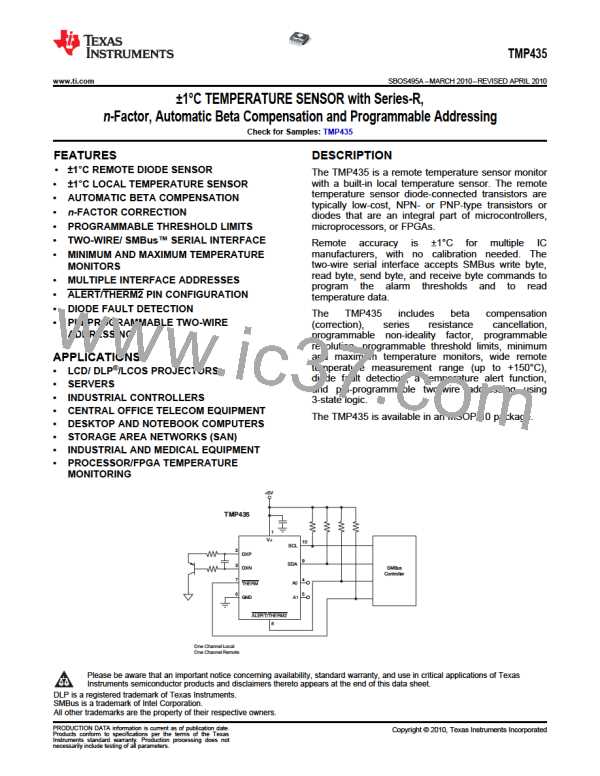TMP435
www.ti.com
SBOS495A –MARCH 2010–REVISED APRIL 2010
APPLICATION INFORMATION
correct for any changes in the beta factor as a result
of temperature variation. The device can operate a
PNP transistor with a beta factor as low as 0.1. See
the Beta Compensation Configuration Register
section for further information.
The TMP435 (two-channel) is a digital temperature
sensor that combines
measurement channel and
temperature measurement channel in
package. This device is two-wire- and SMBus
interface-compatible, and is specified over
a
local die temperature
remote junction
single
a
a
a
Series Resistance Cancellation
temperature range of –40°C to +125°C. The TMP435
contains multiple registers for holding configuration
information, temperature measurement results,
temperature comparator maximum/minimum limits,
and status information. User-programmed high and
low temperature limits stored in the TMP435 can be
used to trigger an over/under temperature alarm
(ALERT) on local and remote temperatures.
Additional thermal limits can be programmed into the
TMP435 and used to trigger another flag (THERM)
that can be used to initiate a system response to
rising temperatures.
Series resistance in an application circuit that typically
results from printed circuit board (PCB) trace
resistance and remote line length is automatically
cancelled by the TMP435, preventing what would
otherwise result in a temperature offset. A total of up
to 1kΩ of series line resistance is cancelled by the
TMP435 if beta correction is disabled and up to 300Ω
of series line resistance is canceled if beta correction
is enabled, eliminating the need for additional
characterization and temperature offset correction.
See the two Remote Temperature Error vs Series
Resistance typical characteristic curves (Figure 7 and
Figure 8) for details on the effect of series resistance
on sensed remote temperature error.
For proper remote temperature sensing operation, the
TMP435 requires only
between DXP and DXN.
a
transistor connected
The SCL and SDA interface pins require pull-up
resistors as part of the communication bus, while
ALERT and THERM are open-drain outputs that also
need pull-up resistors. ALERT and THERM may be
shared with other devices if desired for a wired-OR
Differential Input Capacitance
The TMP435 can tolerate differential input
capacitance of up to 2200pF with minimal change in
temperature error. The effect of capacitance on
sensed remote temperature error is illustrated in
Figure 9 and Figure 10, Remote Temperature Error
vs Differential Capacitance. See the Filtering section
for suggested component values where filtering
unwanted coupled signals is needed.
implementation.
A
0.1mF power-supply bypass
capacitor is recommended for good local bypassing.
See Figure 13 for a typical configuration.
Beta Compensation
Previous generations of remote junction temperature
sensors were operated by controlling the emitter
current of the sensing transistor. However,
examination of the physics of a transistor shows that
VBE is actually a function of the collector current. If
beta is independent of the collector current, then VBE
may be calculated from the emitter current. In earlier
generations of processors that contained PNP
transistors connected to these temperature sensors,
controlling the emitter current provided acceptable
temperature measurement results. At 90nm process
geometry and below, the beta factor continues to
decrease and the premise that it is independent of
collector current becomes less certain.
Temperature Measurement Data
Temperature measurement data are taken over a
default range of 0°C to +127°C for both local and
remote locations. However, measurements from
–55°C to +150°C can be made both locally and
remotely by reconfiguring the TMP435 for the
extended temperature range, as described in this
section. Temperature data resulting from conversions
within the default measurement range are
represented in binary form, as shown in Table 1,
Standard Binary column. Note that any temperature
below 0°C results in a data value of zero (00h).
Likewise, temperatures above +127°C result in a
value of 127 (7Fh). The device can be set to measure
over an extended temperature range by changing bit
2 (RANGE) of Configuration Register 1 from low to
high. The change in measurement range and data
format from standard binary to extended binary
occurs at the next temperature conversion.
To manage this increasing temperature measurement
error, the TMP435 controls the collector current
instead of the emitter current. The TMP435
automatically detects and chooses the correct range
depending on the beta factor of the external
transistor. This auto-ranging is performed at the
beginning of each temperature conversion in order to
Copyright © 2010, Texas Instruments Incorporated
Submit Documentation Feedback
9
Product Folder Link(s): TMP435

 TI [ TEXAS INSTRUMENTS ]
TI [ TEXAS INSTRUMENTS ]